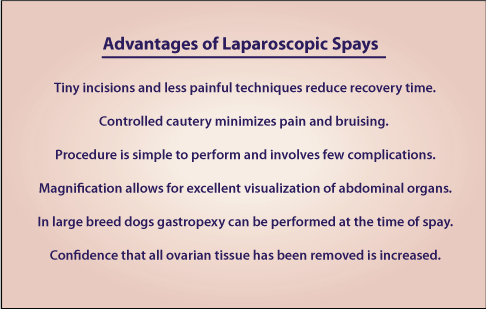A less painful and safer alternative
Traditional surgical spay or ovariohysterectomy (removal of both ovaries and the uterus to the cervix) has been an effective and humane means of neutering female dogs for many decades. The procedure is performed through an incision in the abdomen, below the belly button. The size of the incision will vary with surgeon skill and the methods used.
During the traditional procedure, a ligament, called the suspensory ligament, is torn to release the ovary so that it may be removed from the abdomen and the blood vessels “tied off” (ligated). This tearing causes the majority of postoperative pain, may cause bruising to the abdominal wall and rarely, hemorrhage. The use of suture material or metal clips to ligate blood vessels leaves risk for bleeding should they slip off. The need to manipulate the ovary and uterus out of the abdomen while keeping the abdominal incision as small as possible, creates the circumstances responsible for many of the surgical risks associated with traditional spays.
The advent of laparoscopy, a minimally invasive surgical technique which allows for the use of a camera and surgical instruments through small incisions, has lead to the first advance in spaying since the procedure became routine generations ago. You can now choose this advanced alternative to the traditional spay for your pet.
During the laparoscopic procedure, we are able to perform the surgery with magnified views of the organs, allowing for greater precision and safety. The ovarian suspensory ligament is carefully cauterized and cut under direct visualization, rather than blindly torn by feel. VLS utilizes Ligasure®, an advanced electrosurgical device which uses radio waves to cauterize blood vessels and tissues. Ligasure’s feedback technology creates a collagen weld, sealing vessels in a manner that cannot slip off. The entire procedure is performed within the abdomen eliminating the risks associated with pulling the ovaries out of the abdomen before their attachments to the body are safely tied off.
Now that minimally invasive options are available, there is a better way to approach procedures, such as spays, that require surgery within the abdominal cavity.
If you would like more information about laparoscopic spays and other minimally invasive procedures, or would like to schedule an appointment, please contact your veterinarian or Dr. Keith Gunby at Veterinary Laparoscopic Services.

